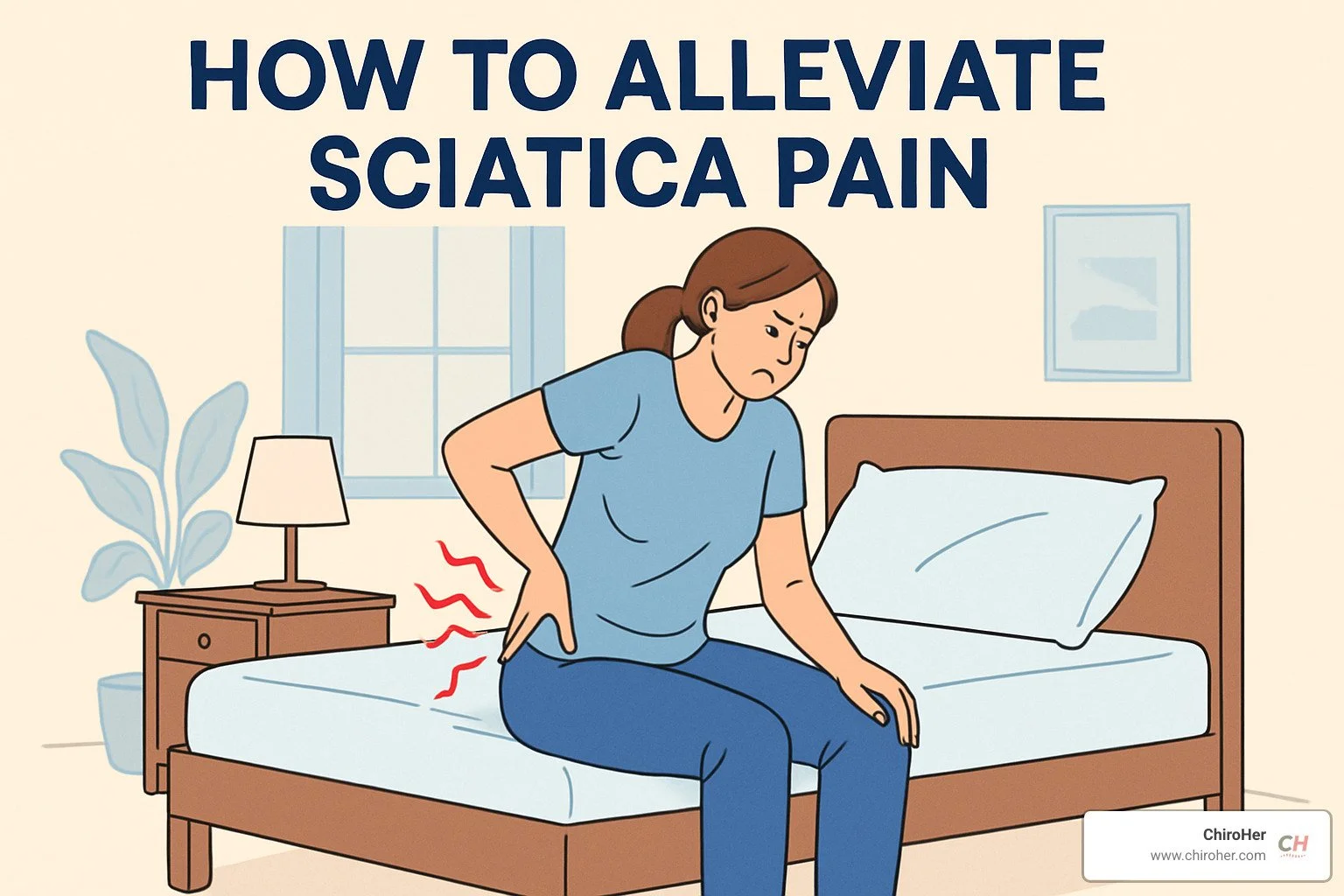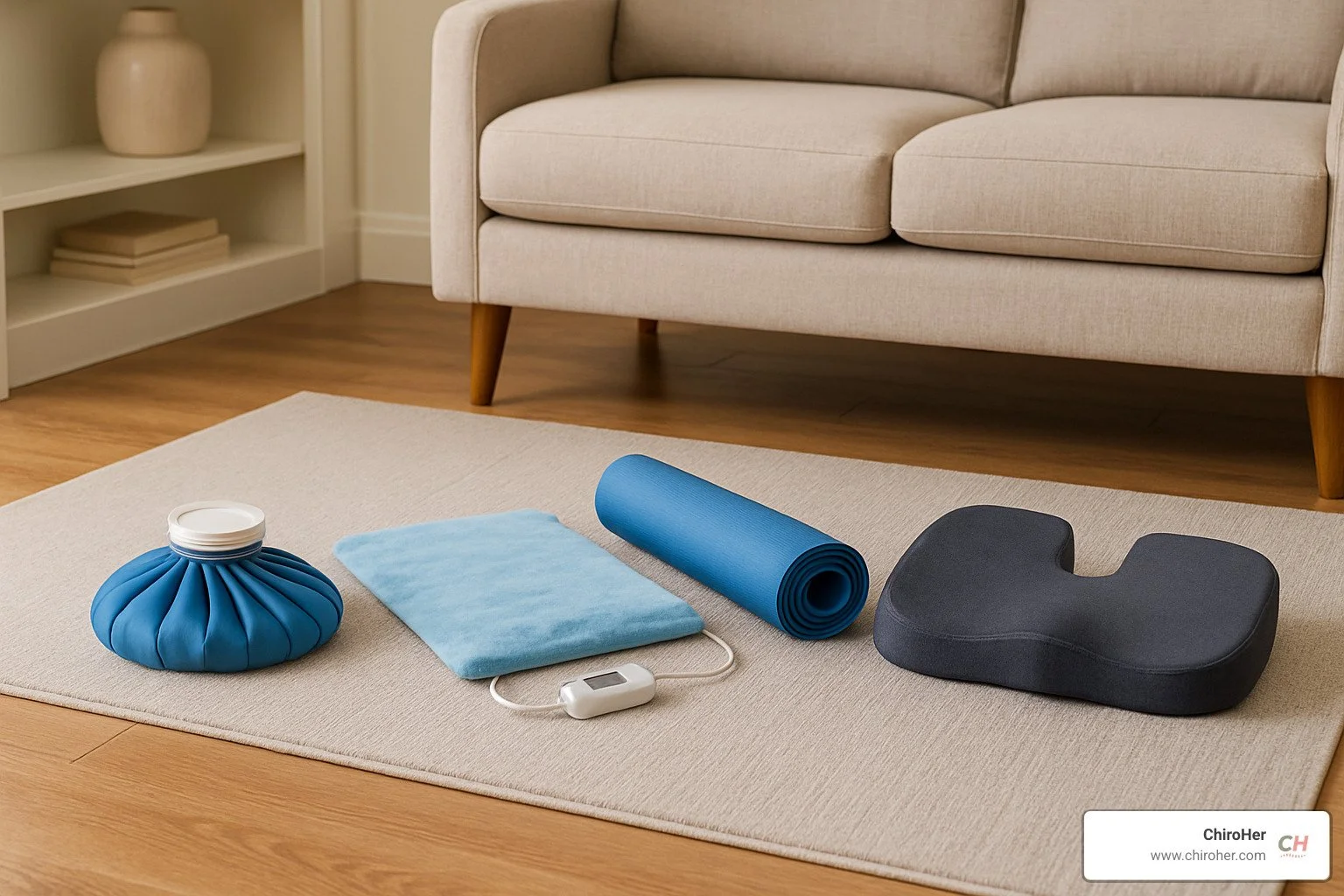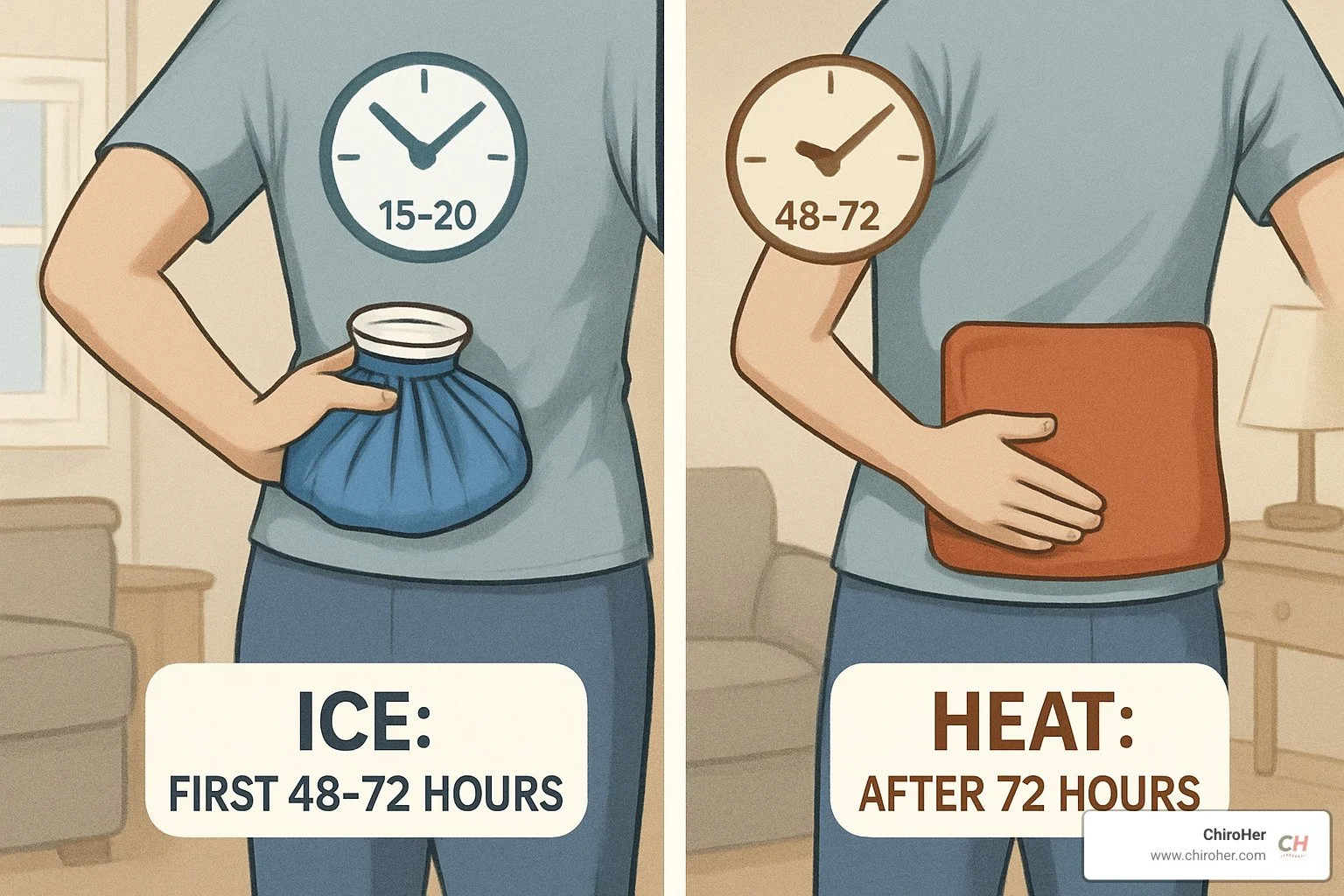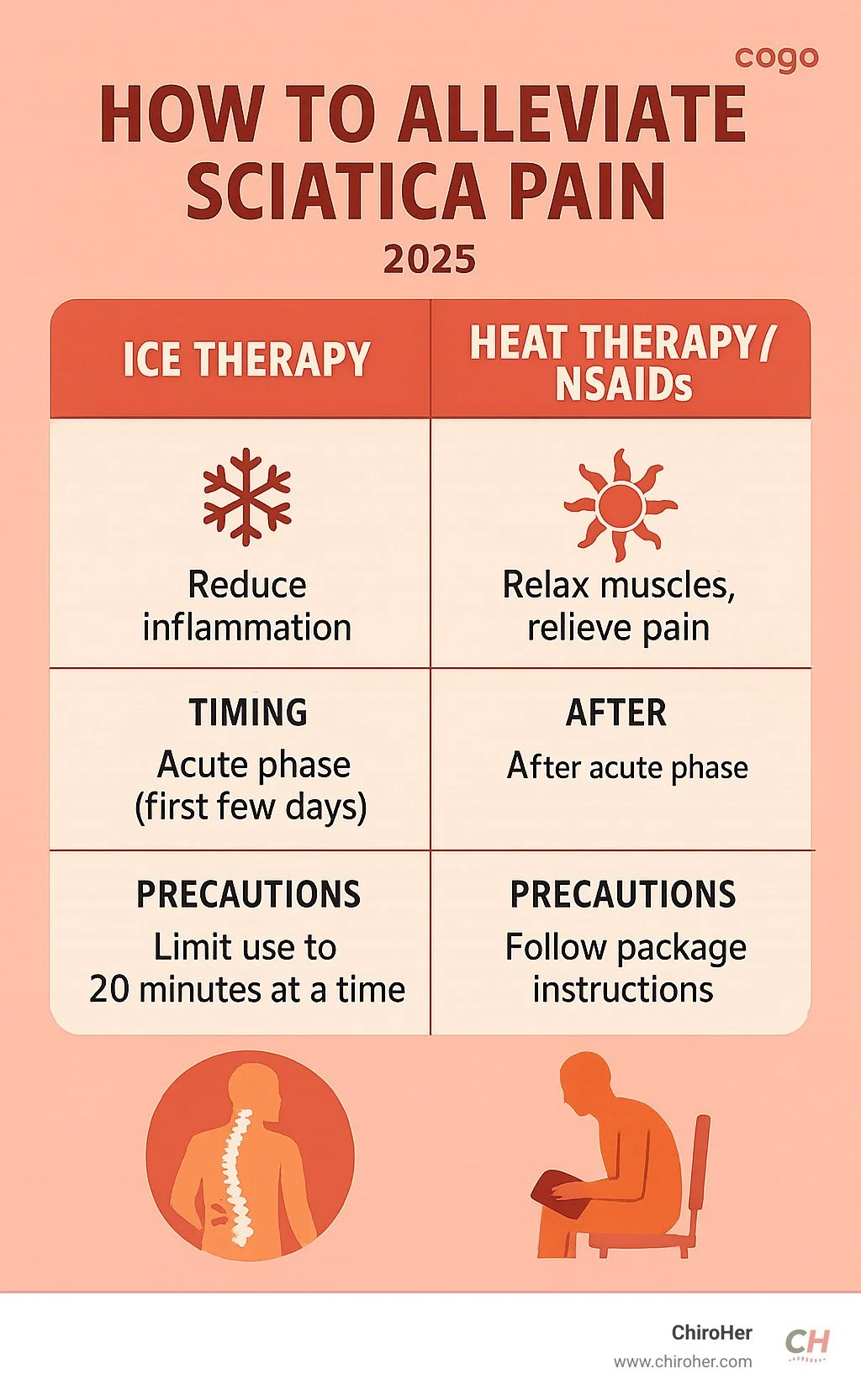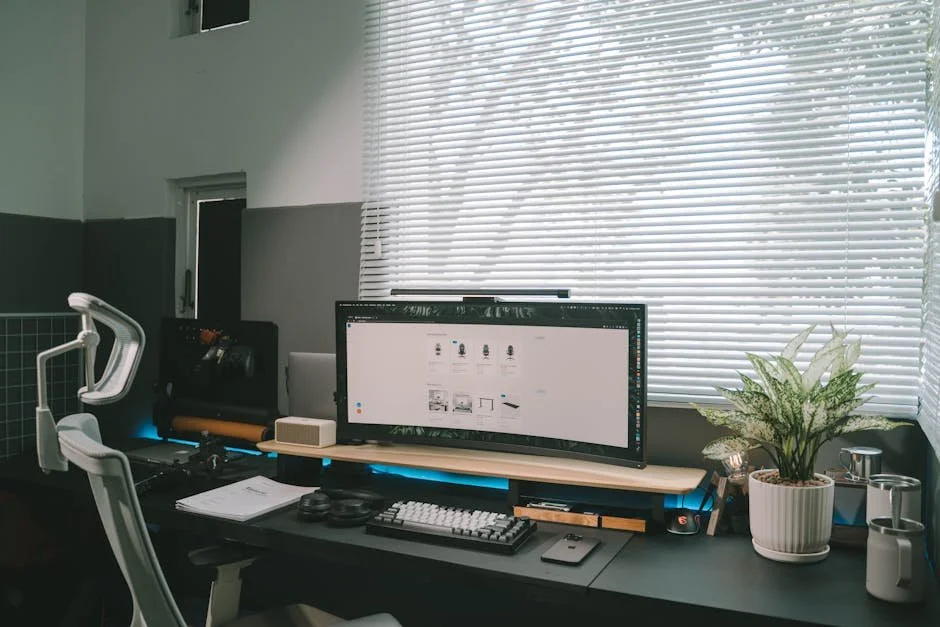How to Alleviate Sciatica Pain Without Losing Your Mind
Understanding Sciatica: The Pain That Changes Everything
How to alleviate sciatica pain starts with understanding what you're dealing with. Here are the most effective methods:
Immediate Relief (First 48 Hours):
Apply ice packs for 15-20 minutes, several times daily
Take over-the-counter NSAIDs like ibuprofen
Stay gently active with short walks
Use proper posture with lumbar support
After 48 Hours:
Switch to heat therapy (heating pad, warm bath)
Perform gentle stretches like figure-4 and knee-to-chest
Continue light movement and avoid bed rest
Consider Epsom salt baths with essential oils
When to See a Doctor:
Pain persists beyond 6 weeks
Numbness or weakness in legs
Loss of bladder or bowel control
Severe pain that prevents normal activities
Sciatica happens when the sciatic nerve - the longest nerve in your body running from your lower back through your legs - gets irritated or compressed. About 40% of people in the U.S. experience some form of sciatica during their lifetime, but here's the good news: 80-90% of people recover without surgery, and about half improve within six weeks.
As Dr. Michelle Andrews, founder of ChiroHer in Oklahoma City, I've helped countless patients learn how to alleviate sciatica pain through personalized chiropractic care and evidence-based techniques. My Webster Technique certification and extensive training in prenatal care have shown me that the right approach can make all the difference in your recovery.
Recognizing Sciatica: Causes, Risk Factors, Red Flags
Your sciatic nerve is the body's biggest electrical cable - up to 2 centimeters wide, running from your lower back to your toes. When something pinches or irritates this nerve, the pain can feel like lightning shooting down your leg.
The most common cause is a herniated disc, where the soft center of a spinal disc pushes through its outer shell and presses against the nerve. Spinal stenosis occurs when spaces in your spine narrow, creating a traffic jam for your nerves. Piriformis syndrome happens when a small muscle in your buttock goes into spasm and squeezes the sciatic nerve.
Pregnancy can trigger sciatica as your growing baby puts pressure on the nerve, while hormonal changes loosen ligaments. Bone spurs from arthritis can also crowd the nerve space.
Risk factors include age (most common between 30-60), obesity, diabetes, prolonged sitting, heavy lifting, and previous back injuries.
Emergency warning signs requiring immediate medical attention:
Loss of bladder or bowel control
Foot drop (inability to lift your foot)
Numbness around genitals
Sciatica affecting both legs
These could signal cauda equina syndrome, which requires emergency surgery to prevent permanent nerve damage.
For more detailed information about sciatica symptoms and diagnosis, check out this Scientific research on sciatica symptoms.
How to tell if it's really sciatica
The straight-leg raise test can help identify true sciatica. Lie on your back and have someone slowly lift your affected leg while keeping your knee straight. If this reproduces your pain when your leg is raised between 30 and 70 degrees, you're likely dealing with sciatica.
Real sciatica follows a specific path: starting in your lower back, traveling through your buttock, and shooting down the back or side of your leg. It's usually sharp, burning, or feels like an electric shock rather than a dull ache.
How to Alleviate Sciatica Pain Without Leaving Home
When sciatica strikes, your first instinct might be to crawl into bed and wait it out. But here's what I've learned after years of treating patients at ChiroHer: how to alleviate sciatica pain often starts with simple tools you already have at home.
About 90% of people with sciatica get better without surgery, and most see significant improvement within a few weeks when they use the right self-care strategies.
Movement is Your Medicine
Staying active is probably the most important thing you can do for sciatica relief. Bed rest beyond the first day or two actually makes things worse by weakening muscles and increasing stiffness.
Start with short walks around your house or neighborhood. Even five minutes of gentle walking can help reduce stiffness and improve blood flow. If walking increases your pain significantly, scale back the distance, but don't stop moving entirely.
Creating a Spine-Friendly Environment
When sitting, use a chair with good lumbar support or place a small pillow behind your lower back. Keep your feet flat on the floor and avoid crossing your legs. Remove your wallet from your back pocket - this can create uneven pressure on your sciatic nerve when you sit.
Strategic Pain Relief
OTC NSAIDs like ibuprofen or naproxen are particularly helpful for sciatica because they reduce inflammation around the compressed nerve. These work differently than acetaminophen, addressing the underlying inflammation rather than just masking pain.
Mastering Cold and Heat
For the first 48 hours, ice is your best friend. Apply ice packs wrapped in a cloth for 15-20 minutes several times a day to reduce inflammation and provide numbing relief.
After 48-72 hours, switch to heat therapy. Use a heating pad on low setting, take warm baths, or apply hot water bottles for 15-20 minutes at a time. Heat increases blood flow and helps relax tight muscles.
Epsom Salt Baths
Soak in a warm Epsom salt bath for 15-20 minutes. The magnesium can help reduce muscle inflammation and promote relaxation. Add a few drops of lavender or eucalyptus essential oils for additional anti-inflammatory benefits.
For more comprehensive information about managing your symptoms, visit our Low Back & Sciatic Pain resource page.
Quick Steps: How to Alleviate Sciatica Pain in 10 Minutes
When pain strikes suddenly, here's your emergency protocol:
Apply ice for 15-20 minutes on the most painful area
Try the figure-4 stretch: Lie on your back, cross your affected leg's ankle over the opposite knee, and gently pull the unaffected leg toward your chest
Practice deep breathing: Inhale for four counts, hold for four, exhale for six
Safe Self-Care Do's and Don'ts
Do: Keep moving with gentle activities, watch your lifting form, use proper posture Don't: Stay in bed for more than two days, ignore red flag symptoms, lift with your back instead of your legs
The top 5 mistakes people make include complete bed rest, ignoring posture, using heat too early, avoiding all activity, and delaying professional help when symptoms persist.
The Best Exercises and Stretches to Alleviate Sciatica Pain
The right exercises can be more effective than bed rest for sciatica relief. Research shows that 80-90% of people with sciatica get better over time, and the right stretching routine can make that healing process much more comfortable.
Key Stretches for Relief
The figure-4 stretch targets the piriformis muscle, which frequently contributes to sciatica pain. Lie on your back, bend both knees, and cross your affected leg's ankle over the opposite knee. Gently pull the unaffected leg toward your chest until you feel a comfortable stretch in your buttock. Hold for 30 seconds and repeat 3 times.
Knee-to-chest stretches decompress your lower spine. While lying on your back, bring one knee toward your chest and hold it with both hands. This creates space between your vertebrae and can provide immediate relief. Hold for 30 seconds and repeat 3 times per leg.
Hamstring stretches are crucial because tight hamstrings can worsen sciatica pain. Stand with your affected leg on a slightly raised surface like a step. Flex your foot and gently lean forward from your hips, keeping your back straight. Hold for 30 seconds.
Strengthening Exercises
Bird-dog exercises build core stability without stressing your spine. Start on your hands and knees, then extend your opposite arm and leg simultaneously. Hold for 5-10 seconds and repeat 10 times on each side.
Glute bridges strengthen your glutes, which act like a natural back brace. Lie on your back with knees bent, then lift your hips by squeezing your glutes. Hold for 5 seconds and repeat 10-15 times.
Nerve glides help your sciatic nerve move more freely. Sit in a chair and straighten your affected leg while pointing your toes up, then flex your foot. Repeat this movement 10 times slowly.
For more comprehensive exercise protocols, explore our Therapeutic Exercises programs.
Daily Routine: How to Alleviate Sciatica Pain with Stretching
Morning: Start with knee-to-chest stretches and pelvic tilts while still in bed. Follow with cat-cow stretches on your hands and knees.
Midday: Take 5 minutes for a piriformis stretch at your workstation. Add gentle spinal twists while seated.
Evening: Focus on figure-4 stretch, hamstring stretches, and glute bridges. End with child's pose for relaxation.
Breathing cues: Never hold your breath during stretches. Use your exhale to gently deepen the stretch.
Exercise Precautions and Modifications
Pregnancy modifications: Use a pregnancy pillow for support and avoid lying flat on your back after the first trimester. Seated versions of most stretches work well during pregnancy.
Chair-based options: Perform seated piriformis stretches, seated spinal twists, and ankle pumps right from your desk chair.
When to stop: Stop immediately if you experience sharp, shooting pain down your leg, increased numbness or tingling, or any loss of muscle control. Mild discomfort during stretching is normal, but sharp pain means you need to back off.
Smart Use of Ice, Heat, and Over-The-Counter Relief
Timing is everything when it comes to ice, heat, and pain medications for sciatica. Get the timing wrong, and you might make your pain worse. Get it right, and you'll have powerful tools for faster relief.
The Critical First 48 Hours
When sciatica first flares up, your body's natural response is inflammation. Ice becomes your best friend during this phase. Wrap an ice pack in a thin cloth and apply it to the most painful area for 15-20 minutes at a time. Never put ice directly on your skin.
Repeat this cycle 3-5 times throughout the day. The key is consistency during these first crucial days.
Making the Switch to Heat
After about 48-72 hours, switch to heat therapy. Heat increases blood flow to the affected area, bringing fresh oxygen and nutrients while helping to flush out pain-causing chemicals. Use a heating pad on low setting, take warm baths, or apply hot water bottles for 15-20 minutes at a time.
The Power of Alternating Therapy
Some people find that alternating between cold and heat works wonders. Try 15 minutes of ice followed by 15 minutes of heat. This combination can help control inflammation while promoting muscle relaxation and blood flow.
Medication That Actually Helps
NSAIDs like ibuprofen and naproxen are particularly effective because they target the inflammation that's often causing your nerve pain. They're not just masking the pain - they're addressing part of the problem.
Ibuprofen can be taken every 4-6 hours as needed, while naproxen lasts longer and only needs to be taken every 8-12 hours. Acetaminophen won't reduce inflammation but can help with pain relief and is gentler on your stomach.
Topical creams with menthol or capsaicin can provide localized relief without systemic effects.
For comprehensive, evidence-based information on therapy effectiveness, check out this Scientific research on cold-to-hot therapy.
Medication Safety Checklist
Follow dosing limits carefully - more isn't always better. Always take NSAIDs with food to protect your stomach lining. Drug interactions are common, so ask your pharmacist about potential problems with other medications.
Call your pharmacist if you experience stomach pain while taking NSAIDs, need pain medication for more than 10 days, or have kidney or liver problems.
Ice, Heat, and NSAIDs for Different Pain Stages
Acute phase (first 48-72 hours): Ice is your primary tool for reducing inflammation and providing numbing relief. Apply for 15-20 minutes with equal rest periods.
Subacute phase (after 72 hours): Heat becomes more beneficial for promoting blood flow and muscle relaxation. Use heating pads on low settings for 15-20 minutes.
NSAIDs work throughout all phases because they address inflammation at the source. They're most effective when taken consistently rather than just when pain peaks.
Chronic phase: Often benefits from alternating cold and heat therapy, using whichever feels better on any given day.
Advanced Care: When Home Remedies Don't Work
If you've been dealing with persistent pain for more than six weeks, or if your symptoms are getting worse, it's time to consider professional help. Surgery is needed in less than 10% of sciatica cases.
Getting the Right Diagnosis
Your healthcare provider might recommend imaging studies to pinpoint what's causing your sciatica. An MRI provides detailed images of soft tissues including discs, nerves, and muscles, while X-rays help identify bone spurs or structural problems.
EMG (Electromyography) measures electrical activity in your muscles to assess nerve function, while nerve conduction studies test how well electrical signals travel through your nerves.
Building Your Treatment Plan
Physical therapy often becomes the cornerstone of recovery, with therapists designing personalized exercise programs to correct posture, strengthen your core, and improve range of motion.
Chiropractic care can be particularly effective for sciatica relief. At ChiroHer, we use gentle techniques like the Activator Method, focusing on realigning the spine and reducing nerve irritability through precise, low-force adjustments.
When conservative treatments need extra support, corticosteroid injections can provide significant relief. These epidural steroid injections deliver anti-inflammatory medication directly to the affected nerve root, with relief lasting several months.
Learn more about our approach to Spinal Manipulation and how Chiropractor Help with Sciatica can provide lasting relief.
Professional Diagnosis and Treatment Ladder
Modern sciatica treatment follows a systematic approach, starting with the gentlest options and progressing only if needed. Imaging studies help identify the exact source of nerve compression. PT scripts provide targeted physical therapy for your particular condition.
If conservative treatments aren't providing adequate relief after several weeks, injection therapy becomes an option. These outpatient procedures can provide months of relief.
Surgery remains the last resort, typically only considered for severe weakness, loss of function, bowel or bladder control issues, or unbearable pain that hasn't improved after 6-8 weeks of conservative treatment.
Complementary Therapies with Evidence
Acupuncture has shown remarkable results in clinical trials, with some studies finding it more effective than certain medications for reducing sciatica pain and improving function.
Massage therapy can significantly improve mobility and reduce muscle tension that contributes to sciatica. Yoga and mindfulness practices combine physical stretching with stress reduction.
At ChiroHer, we integrate these complementary approaches with traditional chiropractic care to provide comprehensive treatment for our patients throughout Oklahoma City, Yukon, Edmond, Nichols Hills, Del City, Mustang, and Moore.
Keep Sciatica From Coming Back
Once you've had sciatica, you're more likely to get it again. But with the right prevention strategies, you can significantly reduce your risk of future episodes.
Creating a Spine-Friendly Workspace
Proper seating starts with a chair that supports your lower back's natural curve. Your feet should rest flat on the floor, and your computer screen should be at eye level. Every 30-60 minutes, stand up and move around.
Standing desks help by allowing you to alternate between sitting and standing throughout the day, reducing pressure on your lower back.
Building Your Body's Natural Back Brace
Your core muscles act like a natural back brace. Planks are highly effective - start by holding for 15-30 seconds and repeat three times. Side planks target the muscles that stabilize your spine from the sides.
Hip mobility work is equally important. Tight hip flexors and hamstrings can pull on your lower back, creating the perfect storm for sciatica.
Weight management plays a bigger role than you might think. Every pound of body weight puts about four pounds of pressure on your lower back. If you smoke, quitting is one of the best things you can do for your spinal health.
For more information about prevention, read our blog post on How Does Chiropractic Treatment Help in Alleviating Back Pain?
Everyday Habits That Protect Your Spine
Lift with your legs, not your back - squat down by bending your knees, keep objects close to your chest, and avoid twisting while lifting.
Sleep position matters. Back sleepers should place a pillow under their knees. Side sleepers should put a pillow between their knees. Your mattress should be medium-firm and replaced every 7-10 years.
Remove your wallet from your back pocket to prevent uneven pressure when sitting. Take walking breaks every hour if you have a desk job. Stay well-hydrated - your spinal discs are largely composed of water.
Long-Term Strength and Flexibility Plan
Pilates and yoga are excellent long-term strategies for preventing sciatica recurrence. Both emphasize core strength, flexibility, and body awareness.
Monthly check-ins with yourself help you stay on track. Assess your pain levels, function, and exercise tolerance.
Regular professional care is like getting regular oil changes for your car. At ChiroHer, we help patients throughout Oklahoma City, Yukon, Edmond, Nichols Hills, Del City, Mustang, and Moore maintain their spinal health through personalized care plans.
Frequently Asked Questions about Sciatica Relief
How long does sciatica usually last?
Most people with sciatica start feeling better within 4-6 weeks with proper self-care. Research shows that roughly half of people recover in about six weeks, and 80-90% improve without surgery.
Several factors can influence recovery speed. Severe nerve compression takes longer to heal than mild irritation. Diabetes, poor posture habits, staying sedentary, or smoking can slow the healing process.
If your pain persists beyond 6-8 weeks or seems to be getting worse, seek professional evaluation.
Should I rest or stay active when pain flares?
Staying active is usually better than complete rest, even when you're hurting. Prolonged bed rest can make sciatica worse by allowing muscles to weaken and joints to stiffen.
During a pain flare, think "active rest." Take short, gentle walks. Do basic stretches as your body allows. Change positions frequently. Use ice for the first 48 hours of a flare, then switch to heat.
Avoid high-impact activities like running during flares. Skip heavy lifting or twisting motions. Don't sit or stand in one position for extended periods.
When is surgery really necessary?
Surgery is needed in less than 10% of sciatica cases. Most people find relief through conservative treatments.
Emergency situations requiring immediate surgery include cauda equina syndrome (loss of bladder or bowel control), severe progressive muscle weakness, or complete foot drop.
Elective surgery might be considered when you have severe pain that hasn't improved after 6-8 weeks of conservative treatment, or when pain significantly impacts your quality of life despite trying multiple approaches.
The decision for surgery should always be made carefully with your healthcare team. Time is often the best healer for sciatica.
Wrap-Up
Learning how to alleviate sciatica pain doesn't have to be overwhelming. With the right combination of immediate relief strategies, targeted exercises, smart use of ice and heat, and lifestyle modifications, most people can find significant improvement in their symptoms.
The truth is, sciatica is often a temporary visitor that improves with time and appropriate self-care. The key is staying active even when you don't feel like it, using evidence-based treatments that actually work, and knowing when to seek professional help.
About 80-90% of people with sciatica get better without surgery. Your body has an amazing capacity to heal itself when you give it the right support. Sometimes that support comes from ice packs and gentle stretches in your living room. Other times, it means working with healthcare professionals who understand your unique situation.
At ChiroHer, we understand that every patient's sciatica experience is unique. What works for your neighbor might not work for you, and that's perfectly normal. Our award-winning, patient-focused approach combines gentle chiropractic adjustments, acupuncture, and holistic wellness strategies to address not just your symptoms, but the underlying causes of your pain.
Whether you're dealing with pregnancy-related sciatica that's making it hard to sleep, work-related back pain from too many hours at a desk, or chronic nerve issues that keep flaring up, we're here to help you find lasting relief. We specialize in women's health and prenatal care, offering personalized treatment plans that actually fit your lifestyle and goals.
Our comfortable, upscale clinic serves patients throughout Oklahoma City, Yukon, Edmond, Nichols Hills, Del City, Mustang, and Moore. We know that dealing with pain is stressful enough without worrying about whether your healthcare provider truly understands your needs.
Don't let sciatica control your life any longer. The strategies in this article can help you start feeling better today, and professional care can help you stay that way. Contact ChiroHer today to schedule a consultation and take the first step toward pain-free living. Your spine - and your sanity - will thank you.



